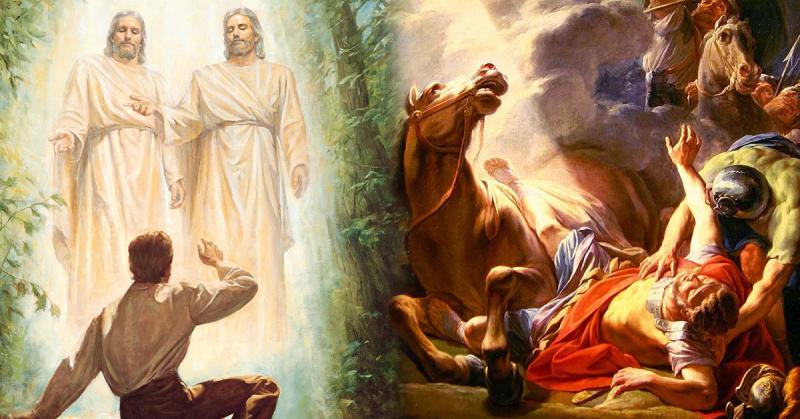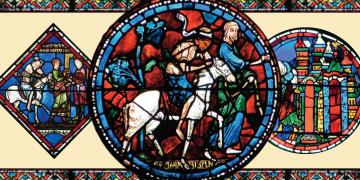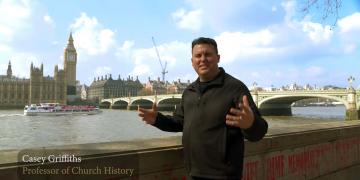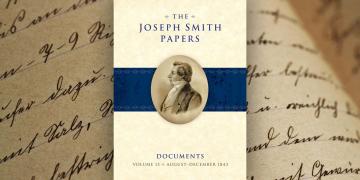You are here
Book of Mormon Central is in the process of migrating to our new Scripture Central website.
We ask for your patience during this transition. Over the coming weeks, all pages of bookofmormoncentral.org will be redirected to their corresponding page on scripturecentral.org, resulting in minimal disruption.
Joseph Smith claimed that in 1820 he beheld a vision of God the Father and His son Jesus Christ. This “First Vision” started Joseph Smith on a path that ultimately led to the Restoration of Jesus Christ’s church in the latter days. Four accounts of the First Vision were written or dictated by Joseph himself. Five other accounts come from what others remembered him saying about his vision. Together, these accounts make the First Vision “the best-documented theophany—vision of God—in history.”1 Even though these accounts differ somewhat in emphasis and detail, they can still be pondered and cherished as supporting witnesses to this crucial and pivotal event of the Restoration. That is because the most important parts of the vision are consistent in each retelling.2
Joseph Smith wasn’t the first person to experience a miraculous manifestation from God. Nor was he the first prophet or apostle to report a sacred experience in different ways to different audiences. In the Book of Mormon, Alma the Younger experienced a miraculous conversion that involved a thundering angel, the quaking of the earth, and Alma’s own incapacitation for three days. Alma recorded this phenomenal experience three times, each time giving a slightly varying account (Mosiah 27:8–37, Alma 36:4–26 and 38:6–8).3
Similarly, the New Testament contains no less than five accounts of the Apostle Paul’s conversion.4 Two accounts come from epistles that most scholars believe were written by Paul himself (1 Corinthians 15:3–8; Galatians 1:15–24). They don’t give much detail about the event, other than that Paul saw Jesus Christ after His resurrection. The three other accounts come from the book of Acts, which was written by the author of the Gospel of Luke (Acts 9:3–30; 22:6–21; 26:12–21). These accounts are more detailed, literary, and vary from audience to audience.
- In Acts 9, Luke gave the initial account of Paul’s journey on the road to Damascus, where he saw a light from heaven and heard the voice of the Lord admonishing him to go to Damascus for more instructions. Paul was blinded and later healed by Ananias (Acts 9:1–8).
- In Acts 22, Paul recounted his divine experience to Jews gathered at the Jerusalem temple (22:6–21) as a defense against their attacks and attempted arrest. Since Paul was speaking to an hostile Jewish audience, he emphasized his own Jewish upbringing and his zeal for persecuting Christians before he received an undeniable witness of Jesus Christ. When Paul recounted this experience, he refered to Jesus as the “Nazarene,” and Jesus does not mention Paul kicking “against the pricks.”
- In Acts 26, Paul testified of his miraculous encounter with Christ before King Agrippa, after having been imprisoned for a year (26:12–21). Because Paul was defending himself against a government audience, he may have framed his story so that Christianity did not pose a threat to Rome. Paul included more details about what Jesus said to him, such as how Jesus called him to be “a minister and a witness” of the vision and the gospel of Christ (v. 16).
Varying retellings of a story do not necessarily detract from its authenticity. In fact, some variation is expected—especially from second-hand sources—and can even enhance an account’s historical plausibility.5 “Historians expect that when an individual retells an experience in multiple settings to different audiences over many years, each account will emphasize various aspects of the experience and contain unique details.”6
Luke, for example, may have been tailoring his telling of Paul’s conversion in different ways to emphasize certain things to certain audiences.7 Even though Paul’s reported conversion stories in Acts differ in some ways from one another, it doesn’t take away from his first-hand witness of the resurrected Jesus Christ, as Paul twice affirmed in his own epistles. Likewise, differences in the accounts of Alma’s conversion story can enrich our understanding of his testimony. Legal scholar John W. Welch has noted:
The three accounts … consistently reflect different vantage points in Alma’s life. In Mosiah 27, Alma is a young man, spontaneously overwhelmed by the power of the angel and terrified by the prospect of the day of judgment (see Mosiah 27:31). Later in Alma’s life, it is clear that the older man has faithfully and successfully served his Lord and his people all the rest of his days (see Alma 36:24–26) so that he now emphasizes his longing to be present with God (see Alma 36:22).8
Paul, Alma, and Joseph Smith drew strength from their foundational spiritual experiences, and shared them multiple times over the course of their lives. Hundreds of years later, their remarkable testimonies are continuing to build faith in Jesus Christ and help draw millions unto Him.
- 1. Steven C. Harper, Joseph Smith’s First Vision: A Guide to the Historical Accounts (Salt Lake City, UT: Deseret Book, 2012), 1. See also Elder Richard J. Maynes, “The First Vision: Key to Truth,” Ensign, June 2017, 62.
- 2. “First Vision Accounts” Gospel Topics, online at churchofjesuschrist.org. For a discussion on the eight different accounts of the First Vision, see “Joseph Smith’s First Vision Accounts,” Church History Topics, online at churchofjesuschrist.org; “Primary Accounts of Joseph Smith’s First Vision of Deity,” online at josephsmithpapers.org; Steven C. Harper, “The First Vision: A Narrative from Joseph Smith’s Accounts,” Church History, April 27, 2016; Steven C. Harper, Joseph Smith’s First Vision: A Guide to the Historical Accounts (Salt Lake City, UT: Deseret Book, 2012); Richard L. Anderson, “Joseph Smith’s Testimony of the First Vision,” Ensign, April 1996, 10–21; Milton V. Backman Jr., “Joseph Smith’s Recitals of the First Vision,” Ensign, January 1985, 8–17; James B. Allen, “Eight Contemporary Accounts of Joseph Smith’s First Vision – What Do We Learn from Them,” Improvement Era 73 (April 1970): 4–13.
- 3. See Book of Mormon Central, “Why Are there Multiple Accounts of Joseph Smith's and Alma's Visions? (Alma 36:6–7),” KnoWhy 264 (January 20, 2017); John W. Welch, “Three Accounts of Alma's Conversion,” in Reexploring the Book of Mormon: A Decade of New Research, ed. John W. Welch (Salt Lake City and Provo, UT: Deseret Book and FARMS, 1992), 150.
- 4. For discussions on Paul’s various conversion accounts, see Philip H. Kern, “Paul’s Conversion and Luke’s Portrayal of Character in Acts 8–10," Tyndale Bulletin 54, no. 2 (2003): 63–80; Charles W. Hedrick, “Paul’s Conversion/Call: A Comparative Analysis of the Three Reports in Acts,” Journal of Biblical Literature 100, no. 3 (1981): 415–432; David M. Stanley, “Paul’s Conversion in Acts: Why the Three Accounts?” Catholic Biblical Quarterly 15, no. 3 (1953): 315–338; Dannis Hamm, “Paul’s Blindness and Its Healing: Clues to Symbolic Intent (Acts 9; 22 and 26),” Biblica 71, no. 1 (1990): 63–72.
- 5. Scholars are divided on the historical reliability of the events recorded in the book of Acts. For discussions on this topic, see C. K. Barrett, “The Historicity of Acts,” The Journal of Theological Studies 50, no. 2 (1999): 515–534; Craig L. Blomberg, The Historical Reliability of the Gospels (Downers Grove, IL: InterVarsity Press, 2007); Mark Harding, “On the Historicity of Acts: Comparing Acts 9.23–5 with 2 Corinthians 11.32–3,” New Testament Studies 39, no. 4 (1993): 518–538; David Peterson, “Introduction,” pages 16–25 in The Acts of the Apostles, The Pillar New Testament Commentary (Grand Rapids, MI: Eerdmans Publishing Co., 2009).
- 6. “First Vision Accounts” Gospel Topics, online at churchofjesuschrist.org.
- 7. John A. Tvedtnes, “The Voice of an Angel,” in Book of Mormon Authorship Revisited, ed. Noel B. Reynolds (Provo, UT: FARMS, 1997), 312. See also John A. Tvedntes, “Variants in the Stories of the First Vision of Joseph Smith and the Apostle Paul,” Interpreter: A Journal of Latter-day Saint Faith and Scholarship 2 (2012): 73–86.
- 8. Welch, “Three Accounts of Alma’s Conversion,” 153.
Subscribe
Get the latest updates on Book of Mormon topics and research for free








